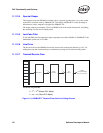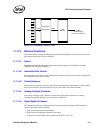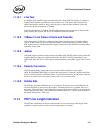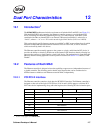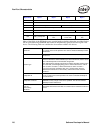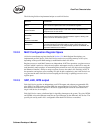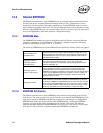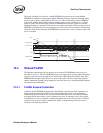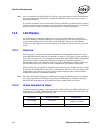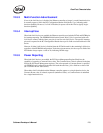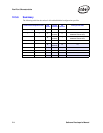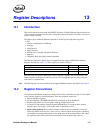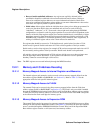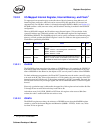
210 Software Developer’s Manual
Dual Port Characteristics
12.3 Shared EEPROM
The Ethernet controller uses a single EEPROM device to configure hardware default parameters
for both LAN devices, including Ethernet Individual Addresses (IA), LED behaviors, receive
packet-filters for manageability and wakeup capability, etc. Certain EEPROM words are used to
specify hardware parameters which are LAN device-independent (such as those that affect circuits
behavior). Other EEPROM words are associated with a specific LAN device. LAN A and LAN B
accesses the EEPROM to obtain their respective configuration settings.
12.3.1 EEPROM Map
The EEPROM map identifies those words configuring both LAN devices or the entire Ethernet
controller component as “LAN A/B Shared”. Those words configuring a specific LAN device
parameters are identified as either “LAN A” or “LAN B”.
The following EEPROM words warrant additional notes specifically related to dual-LAN support:
12.3.2 EEPROM Arbitration
The Ethernet controller uses a single EEPROM to store hardware configuration words for both
LAN devices. The words used by each specific LAN device are noted in the EEPROM map. Each
LAN device obtains its EEPROM configuration parameters by performing its own independent
EEPROM read. Each LAN device reads the entire EEPROM image, verifying the EEPROM
signature, and applying the word(s) appropriate for the specific LAN device. The Ethernet
controller internally arbitrates between EEPROM access by the two LAN devices, to ensure that
each device is able to perform a complete, uninterrupted EEPROM read sequence.
Ethernet Address (IA)
(LAN A/B shared)
The EEPROM specifies the IA associated with the LAN A device and used as
the hardware default of the Receive Address Registers for that device. The
hardware-default IA for the LAN B device is automatically determined by the
same EEPROM word, and is set to the value of {Ethernet IA LAN A with its
least significant bit inverted}.
Initialization Control 1,
Initialization Control 2
(LAN A/B shared)
These EEPROM words specify hardware-default values for parameters that
apply a single value to both LAN devices, such as link configuration
parameters required for auto-negotiation, wakeup settings, PCI/PCI-X bus
advertised capabilities, etc.
Initialization Control 3
(LAN A, LAN B unique)
This EEPROM word configures default values associated with each LAN
device’s hardware connections, including which link mode (internal PHY,
external TBI SerDes) is used with this LAN device. Because a separate
EEPROM word configures the defaults for each LAN, extra care must be taken
to ensure that the EEPROM image does not specify a resource conflict. For
example, multiple LAN devices both attempting to utilize the external TBI
transceiver interface at once.
Management Control
This EEPROM word configures manageability parameters. Note that this word
controls whether an internal ASF controller is enabled/disabled for this LAN,
and whether the SMBus is enabled/disabled for this LAN. Extra care must be
taken to ensure that the EEPROM image does not specify a resource conflict –
if an internal ASF controller is being used, it can only be enabled for a single
LAN device. The SMBus can only be enabled for a single LAN device.



